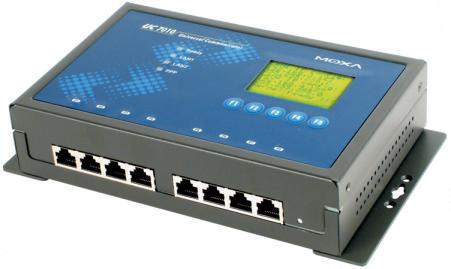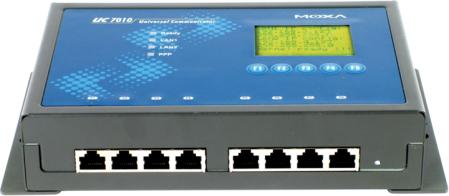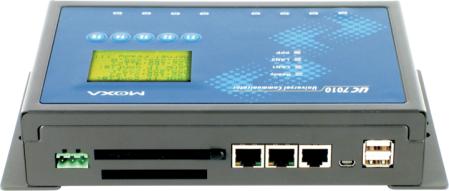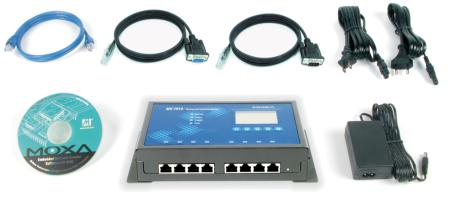Device Profile: Moxa UC-74xx series Serial-to-Ethernet bridges
Jun 28, 2004 — by LinuxDevices Staff — from the LinuxDevices Archive — 16 viewsThe Moxa Technologies UC-7400 and UC-7420 “Universal Communicators” are serial-to-Ethernet adapters enabling remote serial devices in factory and building automation systems to be securely monitored and managed over computer networks. They come pre-installed with Linux, and can be customized with off-the-shelf free software or specially developed applications.

Moxa's UC-7420
The devices are based on a fanless XScale IXP-422 “network processor” system-on-chip from Intel that consumes 2 watts and includes integrated hardware encryption/decryption support for DES, 3DES, AES, and other secure algorithms. Hardware security support means developers can implement secure network interfaces without major performance losses, according to Moxa.
The Communicators support redundant network connections through two 10/100 Ethernet ports, along with eight “3-in-1” serial ports that can be configured in software as RS-232, RS-422, or RS-485 ports.


Front and back views
(Click to enlarge)
The UC-7420 version pictured above adds two USB host interfaces, along with PCMCIA and CompactFlash slots, which can be used to add wireless interfaces, Flash memory, and other expansion functions. Both the UC-7400 and UC-7420 offer one USB client interface.

The “Starter Kit” includes cables
(Click to enlarge)
The UC-74xx series devices boot MontaVista Linux 2.4.18 from a JFFS2 journaling flash file system on 32MB of built-in Flash memory, with storage expansion available on the UC-7420 through the CompactFlash expansion slot. Moxa says JFFS2 protects against possible data loss due to system crashes caused by unexpected power failures, and that the use of Flash memory for storage media results in greater MTBF (mean time between failures) than hard-drive based devices. The devices include 128MB of system RAM.
The devices come with LCD displays and keypads for onsite monitoring, configuration, and troubleshooting. The 160 x 64 dot LCDs provide a text display consisting of 8 rows by 16 columns.
Software side
According to Moxa, a pre-installed Linux OS provides an open source operating system for software development that supports easy GNU tools based cross-compiling on an x86 host/development machine. Moxa ported MontaVista Linux to the device itself, according to Product Manager Charles Chen.
In addition to Linux, the other open source software applications used in the devices include bash, busybox, tinylogin, telnet, SCP, ftp, GCC, GDB, Glibc, pppd, snmpd, telneted, and inetd.
Why Linux?
Chen says Moxa chose Linux because of its reliability and the sophistication of free Linux software available. “We would like to implement Linux on all our current products,” he added.
According to Chen, the greatest challenge was in achieving adequate real-time performance — a challenge which was solved by using MontaVista Linux.
Chen expects the use of Linux to increase in industrial control. “It will be booming, and will dominate the market,” he predicted.
This article was originally published on LinuxDevices.com and has been donated to the open source community by QuinStreet Inc. Please visit LinuxToday.com for up-to-date news and articles about Linux and open source.